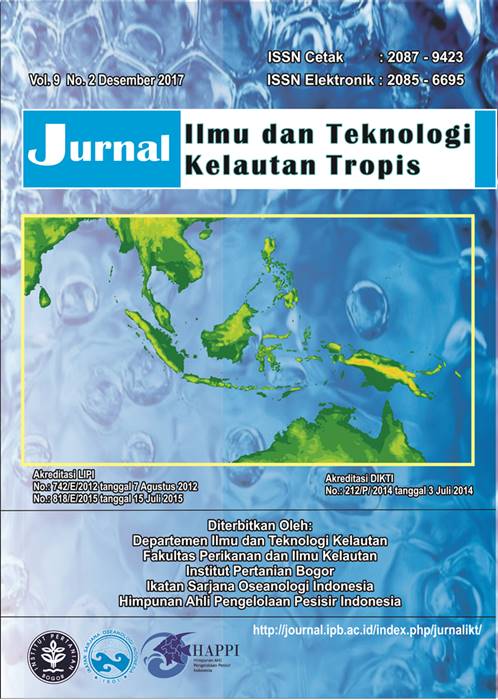SUITABILITY OF LOCATION FOR RESTOCKING CLAMS TRIDACNIDAE IN THE SPERMONDE ARCHIPELAGO
Abstract
Efforts to protect giant clams from extinction one of them through conservation, which set a region as a restocking area. The research aimed to analyze the suitability environments with the density giant clams in the aquatic. The research conducted in September 2013-January 2014. The research site was determined by purposive sampling of middle inner zone = MIZ, middle outer zone = MOZ, and outer zone = OZ in the aquatic of Spermonde Archipelago. The research conducted was using observation method of biology, physics, and chemistry parameters of aquatic at mintakat reef flats, reef slope and reef base. Data analysis of location suitability of restocking giant clams using WSM method (and correlation analysis of giant clams density with water quality, then integrated with ALOS Avnir-2 image. The result research shows the density giant clams influenced by the physical environment parameters, mainly salinity, brightness and depth. The suitability location of restocking giant clams for class Very suitable in P. Langkadea and P. Pala (MOZ), P. Cangke (OZ), P. Tambakulu and P. Kondongbali (OZ) on mintakat reef flats. Class Very suitability on reef slope in P. Kondongbali and P. Kapoposang (OZ). Class accordance with the reef flats, there are P. Podang Podang Lompo (MOZ), P. Sarappo Keke (OZ) and P. Kapoposang (OZ). Class Appropriate to reef slope mintakat in P. Langkadea (MOZ) and P. Sarappo Keke (OZ). Determination of giant clams restocking area in nature needs considers the location suitability, primarily the quality of aquatic physics.
Keywords: conservation, clam, weight sum model, ALOS Avnir-2 image
Authors
This work is licensed under a Creative Commons Attribution 4.0 International License.
Jurnal Ilmu dan Teknologi Kelautan Tropis i is an open-access journal, meaning that all content is freely available without charge to the user or their institution. Users are allowed to read, download, copy, distribute, print, search, or link to the full texts of the articles in this journal without needing to request prior permission from the publisher or the author.
All articles published by Jurnal Ilmu dan Teknologi Kelautan Tropis are licensed under the Creative Commons Attribution 4.0 International License. This allows for unrestricted use, distribution, and reproduction in any medium, provided proper credit is given to the original authors.
Authors submitting manuscripts should understand and agree that the copyright of published manuscripts is retained by the authors. Copyright encompasses the exclusive rights of authors to reproduce, distribute, and sell any part of the journal articles in all forms and media. Reproduction of any part of this journal, its storage in databases, and its transmission by any form or media is allowed without written permission from Jurnal Ilmu dan Teknologi Kelautan Tropis.


